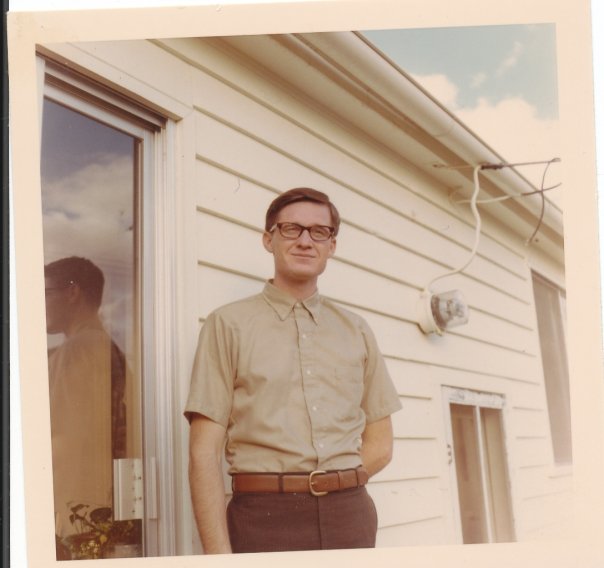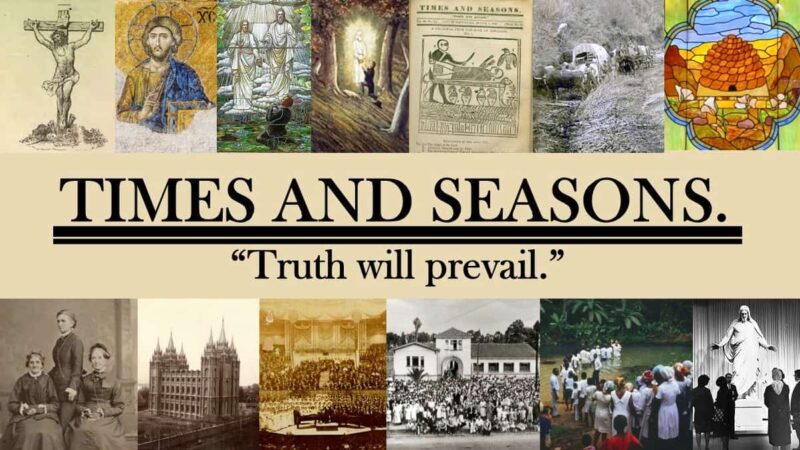-
•
•
12 responses
Since we’re not doing open threads during the sessions of conference, we’re trying to start comment threads at the end of the session, so that once you have heard and thought a little about the entire session and the individual talks. So take your notes during the sessions, and let us know after the session is over. Here’s a few thoughts on Saturday Morning’s session of conference. I’d welcome your thoughts also. Read More
-
•
•
42 responses
I’ll be attending a wedding later today. The couple will be married in the church, and a new baby will be joining them somewhat sooner than later. For a faithful LDS family, this is difficult. Read More
-
•
•
19 responses
The first weekend of April is a time when we look for information, for an understanding of the changes that have happened in the last six months and how that will help us prepare for the next six months. This is because the first weekend of April begins the baseball season. Read More
-
•
•
David Henry Huish, born in the Mormon colony of Morelos, Sonora, Mexico in 1906, and Keith Wynder Burt, born in the Mormon colony of Cardston, Alberta, Canada in 1908, met in the Mission Home in Salt Lake City late in 1928, after both young men had been called to serve missions in South America. After finishing their few days’ training in Salt Lake – which did not include language training – the two young men traveled together by train, via Denver, Chicago, and Washington, D.C., to New York City. They spent two and a half days exploring New York, then… Read More
-
•
•
70 responses
The new tobacco tax in the United States took effect yesterday, which tripled the amount of tax collected on each pack of cigarrettes, and probably raising the cost of a pack to as much as $9. The tax is the single largest increase in tobacco taxes in history. For an LDS audience, this probably seems all fine and good. You aren’t likely to complain about a sin tax if you aren’t committing that sin. And, to be honest, its hard to imagine a sin tax that LDS Church members would be particularly vulnerable to (perhaps ice cream?) But even if… Read More
-
•
•
23 responses
After seeing a reference or two, I noticed a copy of The Big Sort: Why the Clustering of Like-Minded America is Tearing Us Apart at the library and gave it a quick read. The thesis is simple: increased income and mobility over the last five decades has enabled Americans to self-sort geographically into communities surrounded by people they are most comfortable with, namely people like themselves. Read More
-
•
•
3 responses
This looks like the sort of conference that makes me sad at times that I don’t live in Utah: Read More
-
•
•
29 responses
My 13-year-old daughter came down with Bell’s Palsy last weekend. I was reeling a bit from the diagnosis Read More
-
•
•
52 responses
So your mission call finally arrived (see here, here, or here) and you suddenly realize that it starts in 44 days but you don’t know that much about Mormonism or what it is you are supposed to teach for two long years. You are suddenly serious about “missionary prep.” What book should you read? Read More
-
•
•
120 responses
I was only a teenager when the new-fangled consolidated schedule hit the church fashion scene. Read More
-
•
•
In 1916, the Beehive Girls were Latter-day Saint young women ages 14 and 15 (the 12- and 13-year-olds were still in Primary). Older teens, and even the mothers of Beehive Girls, could learn the same skills and earn the same badges of honor, if they chose to. Beehive Girls from Thatcher, Arizona Read More
-
•
•
Jensine was born in Copenhagen, Denmark, in 1837, her parents’ youngest child. Her father died when she was 4, her mother when she was 12; she probably spent her youth in the household of one of her much older brothers. In1857 Jensine was married to Frants Christian Grundvig, a young joiner who had come to Copenhagen a few years earlier to learn his trade. Read More
-
•
•
25 responses
I recently finished up Hans Kung’s Great Christian Thinkers, which reviews the work of seven theologians (Paul, Origen, Augustine, Aquinas, Luther, Schleiermacher, and Barth). From an LDS perspective, the most interesting of the bunch is Friedrich Schleiermacher, who Kung terms “the paradigmatic theologian of modernity.” The question he presents to LDS readers is how our approach to religion and doctrine deals with modernity. Is our approach premodern, modern, or postmodern (which in theology generally means some version of neo-orthodoxy)? Read More
-
•
•
42 responses
Some years ago I had the idea that Mormonism needs an “anti-defamation league”–a group that reviews news coverage and other public actions and publicly condemns those actions that clearly defame Mormons and Mormonism. But I’ve since decided that this is probably not a very workable idea. Read More
-
•
•
34 responses

A few weeks ago my father retired after spending three decades working for the Church Historical Department. I’m no doubt guilty of an excess of filial piety, but I think that the Church and Kingdom are better for the work that he did. Read More
-
•
•
32 responses
So, what is this scary Salamander Letter that the church is hiding from everybody? Read More
-
•
•
43 responses
Some years ago, I noticed a trend among female general auxiliary leaders. With few exceptions, they all lean (no pun intended) to the slimmer side of the LDS population at large (ahem). Much as missionaries have a particular grooming code, is there an unwritten appearance requirement for “upper-level” service? Read More
-
•
•
16 responses
The church has a channel on YouTube called Mormon Messages. Yesterday they posted a new video titled, “Why Mormons Build Temples.” (Comments and ratings are not open on this video.) How do you think this will work as a response to the upcoming airing of recreated temple ceremonies (accurate or not)? Read More
-
•
•
11 responses
From Ernest Renan, a French 19th-century philosopher: Forgetting, and I would say even historical error, is an essential element in the creation of a nation, and that is why the progress of historical studies is often a danger for the nation itself. Read More
-
•
•
While uncounted thousands of visual artists have contributed their skills to building Zion, the Fairbanks dynasty holds a special place in the world of Mormon art history: John B. Fairbanks (1855-1940) was one of the art missionaries sent to Paris by the Church, who came home to paint murals for the temples. His sons J. Leo (1878-1946) and Avard T. (1898-1987) have a catalog that must amount to a hundred or more Mormon-themed works: Read More
-
•
•
34 responses
In the spirit of President Hinckley’s six be’s, I’d like to submit some suggestions for visiting/home teaching etiquette. Here are my 12 be’s of assigned teaching. Please add your own! Read More
-
•
•
9 responses
A couple of years ago, Noah Feldman published “Orthodox Paradox,” an essay in which he recounted some of the tensions of being an Orthodox Jew in the modern world (I ran across it reading The Best American Spiritual Writing 2008). Increasingly, being an orthodox anything in the modern world raises some of the same tensions. Read More
-
•
•
125 responses
Do we have a right to wear garments? If we do, how far does that right go? What , kind of right is it? Is it a human right? Or a legal one that might disappear and reappear as we pass national boundaries? Read More
-
•
•
Laura Liona Rees was born in Brigham City, Utah, in 1876, to LDS parents (her father had emigrated as a convert from England; her mother was born at Council Bluffs). With only an eighth grade, district school education, she studied for and passed the test to be licensed as a grade school teacher. Then she became one of the first women to attend Utah State Agricultural College (now Utah State University) at Logan. Read More
-
•
•
If you’re going to be disappointed by a J. Golden talk that doesn’t fit the swearing-elder stereotype, stop reading now. This isn’t that kind of J. Golden story. It is a talk the future Seventy gave to a small South Carolina branch in 1891 during a period when local members – including a woman – had been whipped and shot at, their homes ransacked, and the missionaries ordered out of the county at gunpoint. Read More
-
•
•
11 responses
It’s hard for Mormons to find an accessible doorway into theology. David F. Ford’s short book Theology: A Very Short Introduction (OUP, 1999) is the first I’ve found to really give me some traction with this elusive subject. Read More
-
•
•
The original Keepapitchinin printed this “editorial” in 1870: Confidential. We have received the following letter: ”Dear Sir: – a confidential friend having notified us that you can be relied on we send you the enclosed circular.” Read More
-
•
•
7 responses
There are a number of Mormon pamphlets and books that have achieved a kind of semi-canonical status within Mormon studies. Everyone agrees, for example, that Parley P. Pratt’s Key to the Science of Theology or John Taylor’s Mediation and Atonement are key texts for understanding nineteenth Mormon thought. If any evidence is needed, both texts, I believe, are still in print. At the very least both have produced modern reprints. I have a proposed addition to the canon, George Q. Cannon’s A Review of the Decision of the Supreme Court in the Case of Geo. Reynolds v. the United States. Read More
-
•
•
30 responses
“And again, it shall come to pass that he that hath faith in me to be healed, and is not appointed unto death, shall be healed. He who hath faith to see shall see. He who hath faith to hear shall hear. The lame who hath faith to leap shall leap.” (D&C 42:48-51) Read More
-
•
•
11 responses
From nearly the moment Thomas L. Kane walked into Mormon history in 1846, Latter-day Saint leaders promised that his name would long be honored by the Saints. In part, they wanted to bolster Kane’s determination to take the deeply controversial stance of defending the Mormons. When his father John, a powerful federal judge, learned of Kane’s decision to befriend the Mormons by traveling to their refugee camps in Iowa in 1846, he saw only potential ruin in associating with such a disreputable cause. “The case has no bright side,” he lamented, as Tom “is about to deal a blow to… Read More
